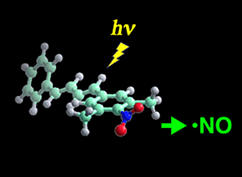Organic and Medicinal Chemistry
Staffs
Hidehiko Nakagawa, Ph.D., Professor
Mitsuyasu Kawaguchi, Ph.D., Associate Professor
Yuhei Ohta, Ph.D., Research Associate
Mitsuyasu Kawaguchi, Ph.D., Associate Professor
Yuhei Ohta, Ph.D., Research Associate
Research Project
- Molecular design, synthesis, and evaluation of biologically functional and useful compounds
- Development of the methods for exploration and analysis for bioactive substances like medical leads based on chemical approach
- Bioorganic chemistry for reactive oxygen species and nitric oxide
- Development of the compounds for controlling cellular properties based on photochemistry and organic chemistry
Oriented toward the development of medical and diagnostic drugs, the studies in medicinal chemistry and chemical biology are conducted. To find attractive lead compounds and to tune them up to novel and useful biofuctional chemicals, we practice comprehensive studies of computational molecular design, synthetic reactions, biological evaluation, and action mechanisms of biofunctional molecules on the basis of organic chemistry. Our research interest includes the development of histone deacetylase inhibitors, photoinduced nitric oxide donors, adipocyte proliferation regulating compounds, DNA methylation regulating compounds, oxidative stress regulating compounds, and so on.
The followings are brief introductions of our biofunctional compounds.
(1) Novel chemial fluorescent probes for deaceylase/deacylase activity to explore potential inhibitors: The probe compounds were designed and synthesized based on the FRET mechanism, and on the finding of deacylation activity of the enzymes for the non-natural acyl moiety containing aromatic quencher group. The synthesized compounds showed potent turn-on fluorescence response for SIRT enzymatic acitvity and some of the probes were also fonund to be applicable for the detection of SIRT activity in living cells. These compounds are expected to become novel tools for exploring new drug candidates.
The followings are brief introductions of our biofunctional compounds.
(1) Novel chemial fluorescent probes for deaceylase/deacylase activity to explore potential inhibitors: The probe compounds were designed and synthesized based on the FRET mechanism, and on the finding of deacylation activity of the enzymes for the non-natural acyl moiety containing aromatic quencher group. The synthesized compounds showed potent turn-on fluorescence response for SIRT enzymatic acitvity and some of the probes were also fonund to be applicable for the detection of SIRT activity in living cells. These compounds are expected to become novel tools for exploring new drug candidates.

(2) Novel photoinduced nitric oxide donors: Inspired by the photoisomerization reaction of nitorobenzene, the compounds which liberate nitric oxide in response to photoirradiation were designed and synthesized. These compounds induced cancer cell death in vitro through nitric oxide production by photoirradiation. These nitric oxide donors are expected to be used as anticancer agents and experimental tools.
Contact information
Prof. Hidehiko Nakagawa, Ph.D.
deco@phar.nagoya-cu.ac.jp
deco@phar.nagoya-cu.ac.jp

